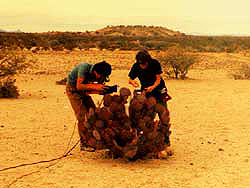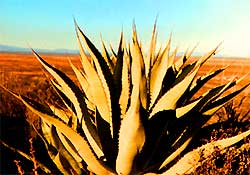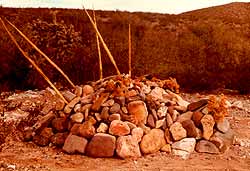Music from The Zone of Silence (1988)
for voices, performers and 2-channel audio
in 3 parts
Premiere: July 1988 Sound Symposium St. John's Nfld Canada
Length: 26:30
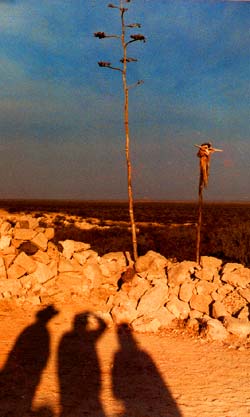
In December/January of 1984/85, 15 artists from 4 cultures camped together in the so-called Zone of Silence in north central Mexico to explore the desert environment through their respective desciplines and to make art.
The Zona del Silencio is known for its strange landscape formations, unusual plant and animal life, for its odd meteorological activity, and for the fact that the earth's magnetic field seems to have a hole there. Tape recorders don't work in part of the Zona, compasses go mad, etc.
The Zone of Silence has been studied by scientists (in 1974, the Allende Meteorite landed there, causing a flurry of research activity by NASA), by Native shamans (the country has numerous ritual and healing sites) but never by contemporary urban-based artists. We camped in the Zone, in an Apache ruin, and did art events, performance, photography, recording, soundmaking, storytelling, sculpture, poetry.
One of the most striking experiences in very quiet environments is the emergence of the desire to make sounds, language and music. It is striking because the constant bombardment of sound we experience in cities all too often puts us out of touch with this desire.
Music from the Zone of Silenceis an attempt to recapture the experience of silence as well as the desire for soundmaking that this environment created in us. The work consists of three perfomance pieces created with the poetry by Norbert Ruebsaat and soundscape tape compositions by Hildegard Westerkamp. The materials (words and sounds) were brought back from the desert and developed into these three pieces for performance at the 1988 Sound Symposium in St. John's, Newfoundland.
1. Desert Wind
Length: 9:00
Wind was a constant presence while we were in the Zone of Silence and it had a number of different "voices", depending on which objects it touched. In the first part of this piece, the primary wind sound comes from a so-called false pine located at the water reservoir in a nearby village. This sound is mixed with the sound of wind blowing on tuned bottles.
I had tuned empty beer and tequila bottles and covered them with rocks, until only the openings of the bottles were visible. As I was piling up the rocks in a fairly random fashion around the bottles the shape of a turtle emerged. The whole process took me about four days and while I was carrying rocks, the wind played its music on the bottles. The sound was surprisingly quiet, but it became a soothing, slightly haunting accompaniment to my work. The longer I worked the more clearly I could hear the "music". I internalized it to such an extent that I could hear it in my inner ear long after I had left the place.
I was never able to record its sound because it was only audible when the wind was strong and gusty. I therefore simulated this experience by blowing on tuned bottles in my studio, recording the sounds and mixing them, with the memory of "the turtle sounds" in mind. The melancholiac character of these sounds became a natural backdrop for Norbert Ruebsaat's poem The Dark Man, which is read live with this first part of Desertwind.
The second part of Desertwind is based on wind sounds created by the group of artists and their children moving bare tree branches in a variety of ways. Group members were standing in a circle around me, the recordist, swinging the branches until they produced a wind sound. Sometimes I would pick up gentle swishing sounds and sometimes, depending on the speed and direction of the movements, I could hear strong rhythmical sounds. It makes for a comparatively more restless "wind soundscape" with interesting interlocking rhythms. The poem Madonna by Norbert Ruebsaat is read with this section of the piece and forms the "companion piece" to The Dark Man in the first section.

2. Meditation
Length: 7:00
Everyone was lying, star-shaped, heads together at the centre of camp, looking at the stars and doing sound/voice explorations. The event lasted several hours. This short section on the tape part of the piece is an excerpt of the longer recording and concentrates on the word "silence" spoken in four languages.
The materials for the live part of this piece consist of three poems by Norbert Ruebsaat (The Language, The Fox, Art Camp),words for silence and/or quiet in various languages and other vocal sound materials suggested by and/or in interaction with the tape. The piece can be performed by no less than two and no more than four people.
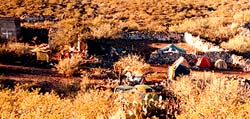
3. The Truth is Acoustic
Length: 10:30
In the absence of found sound in the environment (it was almost totally silent) I went out and made sounds. Since the plants, especially the cacti, were all thick and suggested interior spaces, I began to pluck on their spines, rub and caress their surfaces, pound on them with an improvised drumstick. I recorded the resulting sounds very close up, and later worked with these in the studio. The tape portion of this piece consists of the various percussive sounds that resulted from these close-up recordings as well as group member's voices describing and naming the plants.
The live portion of the piece starts with an improvisation on the clay vase, followed by an improvisation on the sopranino recorder and finally a reading and improvisation of Norbert Ruebsaat's poem The Infinite Ear.
